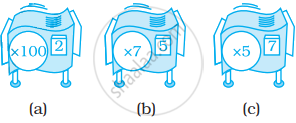Advertisements
Advertisements
प्रश्न
This table shows the mass of one atom for five chemical elements. Use it to answer the question given.
| Element | Mass of atom (kg) |
| Titanium | 7.95 × 10–26 |
| Lead | 3.44 × 10–25 |
| Silver | 1.79 × 10–25 |
| Lithium | 1.15 × 10–26 |
| Hydrogen | 1.674 × 10–27 |
- Which is the heaviest element?
- Which element is lighter, Silver or Titanium?
- List all five elements in order from lightest to heaviest.
उत्तर
Arrangement of masses of atoms in same power of 10 is given by
Titanium = 7.95 × 10–26
Lead = 34.4 × 10–26
Silver = 17.9 × 10–26
Lithium = 1.15 × 10–26
Hydrogen = 0.1674 × 10–26
Thus, we have 34.4 > 17.9 > 7.95 > 1.15 > 0.1674
a. Lead is the heaviest element.
b. Silver = 17.9 × 10–26 and Titanium = 7.95 × 10–26, so titanium is lighter.
c. Arrangement of elements in order from lightest to heaviest is given by
Hydrogen < Lithium < Titanium < Silver < Lead
APPEARS IN
संबंधित प्रश्न
The table shows the mass of the planets, the sun and the moon in our solar system.
| Celestial Body |
Mass (kg) | Mass (kg) Standard Notation |
| Sun | 1,990,000,000,000,000,000,000,000,000,000 | 1.99 × 1030 |
| Mercury | 330,000,000,000,000,000,000,000 | |
| Venus | 4,870,000,000,000,000,000,000,000 | |
| Earth | 5,970,000,000,000,000,000,000,000 | |
| Mars | 642,000,000,000,000,000,000,000,000,000 | |
| Jupiter | 1,900,000,000,000,000,000,000,000,000 | |
| Saturn | 568,000,000,000,000,000,000,000,000 | |
| Uranus | 86,800,000,000,000,000,000,000,000 | |
| Neptune | 102,000,000,000,000,000,000,000,000 | |
| Pluto | 12,700,000,000,000,000,000,000 | |
| Moon | 73,500,000,000,000,000,000,000 |
- Write the mass of each planet and the Moon in scientific notation.
- Order the planets and the moon by mass, from least to greatest.
- Which planet has about the same mass as earth?
The table shows the average distance from each planet in our solar system to the sun.
| Planet | Distance from Sun (km) |
Distance from Sun (km) Standard Notation |
| Earth | 149,600,000 | 1.496 × 108 |
| Jupiter | 778,300,000 | |
| Mars | 227,900,000 | |
| Mercury | 57,900,000 | |
| Neptune | 4,497,000,000 | |
| Pluto | 5,900,000,000 | |
| Saturn | 1,427,000,000 | |
| Uranus | 2,870,000,000 | |
| Venus | 108,200,000 |
- Complete the table by expressing the distance from each planet to the Sun in scientific notation.
- Order the planets from closest to the sun to farthest from the sun.
Two machines can be hooked together. When something is sent through this hook up, the output from the first machine becomes the input for the second. Which two machines hooked together do the same work a (× 102) machine does? Is there more than one arrangement of two machines that will work?

Similarly, repeater machine is a hypothetical machine which automatically enlarges items several times. For example, sending a piece of wire through a (× 24) machine is the same as putting it through a (× 2) machine four times. So, if you send a 3 cm piece of wire through a (× 24) machine, its length becomes 3 × 2 × 2 × 2 × 2 = 48 cm. It can also be written that a base (2) machine is being applied 4 times.

What will be the new length of a 4 cm strip inserted in the machine?
For the following repeater machines, how many times the base machine is applied and how much the total stretch is?

Find three repeater machines that will do the same work as a (× 64) machine. Draw them, or describe them using exponents.
Sanchay put a 1 cm stick of gum through a (1 × 3–2) machine. How long was the stick when it came out?
Neha needs to stretch some sticks to 252 times their original lengths, but her (× 25) machine is broken. Find a hook-up of two repeater machines that will do the same work as a (× 252) machine. To get started, think about the hookup you could use to replace the (× 25) machine.

Find two repeater machines that will do the same work as a (× 81) machine.
The left column of the chart lists the lengths of input pieces of ribbon. Stretching machines are listed across the top. The other entries are the outputs for sending the input ribbon from that row through the machine from that column. Copy and complete the chart.
| Input Length | Machine | |||
| × 2 | ||||
| 1 | 5 | |||
| 3 | 15 | |||
| 14 | 7 | |||
